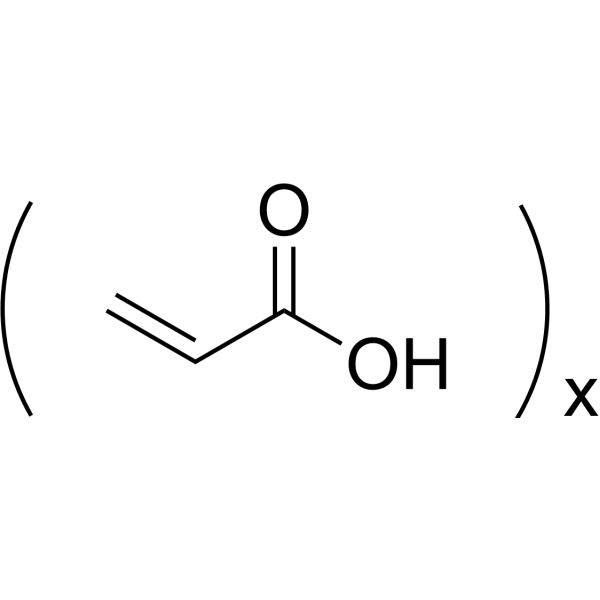Polyacrylic acid

Polyacrylic acid structure
|
Common Name | Polyacrylic acid | ||
|---|---|---|---|---|
| CAS Number | 9003-01-4 | Molecular Weight | 2000(Average) | |
| Density | 1.09 (30% aq.) | Boiling Point | 116ºC | |
| Molecular Formula | (C3H4O2)x | Melting Point | 106ºC | |
| MSDS | Chinese USA | Flash Point | 61.6ºC | |
| Symbol |

GHS08 |
Signal Word | Danger | |
|
Cyclodextrin-crosslinked poly(acrylic acid): adhesion and controlled release of diflunisal and fluconazole from solid dosage forms.
AAPS PharmSciTech 14(1) , 301-11, (2013) The controlled release of diflunisal and fluconazole from tablets made of novel polymers, poly(acrylic acid) (PAA) crosslinked with either β-cyclodextrin (βCD) or hydroxypropyl-βCD (HPβCD), was investigated and Carbopol 934P (Carbopol) was used as a highly cr... |
|
|
Cyclodextrin-crosslinked poly(acrylic acid): Synthesis, physicochemical characterization and controlled release of diflunisal and fluconazole from hydrogels.
Int. J. Pharm. 444(1-2) , 175-84, (2013) The aim of this work was to develop mucoadhesive hydrogels with variable drug delivery properties by crosslinking poly(acrylic acid) (PAA) with cyclodextrins (CDs). CD-PAA polymers with high CD content and good inter-batch reproducibility were synthesized by ... |
|
|
Chest wall reconstruction using biomaterials.
Ann. Thorac. Surg. 95(3) , 1050-6, (2013) Skeletal chest wall reconstruction can be a challenge, depending on the indication, location, and health of the patient; various materials are available. Recently, biomaterials that are remodelable (bovine pericardium patch; Veritas, Synovis Life Technologies... |
|
|
Multifunctional magnetic-fluorescent eccentric-(concentric-Fe₃O₄@SiO₂@polyacrylic acid core-shell nanocomposites for cell imaging and pH-responsive drug delivery.
Nanoscale 5(6) , 2249-53, (2013) Multifunctional fluorescent-magnetic pH-responsive eccentric-(concentric-Fe3O4@SiO2)@polyacrylic acid core-double shell nanocomposites (NCs) have been prepared for simultaneous cell imaging and pH-responsive drug delivery. To confirm the universality of the s... |
|
|
Glycopolymer micelles with reducible ionic cores for hepatocytes-targeting delivery of DOX.
Int. J. Pharm. 441(1-2) , 170-80, (2013) A novel galactose-decorated cross-linked micelles (cl-micelles) with ionic cores using cystamine (Cys) as a biodegradable cross-linker was prepared by using block ionomer complexes of poly(ethylene glycol)-b-poly(2-acryloxyethyl-galactose)-b-poly(acrylic acid... |
|
|
Microwave-assisted synthesis of biocompatible europium-doped calcium hydroxyapatite and fluoroapatite luminescent nanospindles functionalized with poly(acrylic acid).
Langmuir 29(6) , 1985-94, (2013) Europium-doped calcium hydroxyapatite and fluoroapatite nanophosphors functionalized with poly(acrylic acid) (PAA) have been synthesized through a one-pot microwave-assisted hydrothermal method from aqueous basic solutions containing calcium nitrate, sodium p... |
|
|
Poly(acrylic acid)-grafted fluoropolymer films for highly sensitive fluorescent bioassays.
ACS Appl. Mater. Interfaces 5(6) , 2155-60, (2013) In this study, a facile and effective method for the surface functionalization of inert fluoropolymer substrates using surface grafting was demonstrated for the preparation of a new platform for fluorescence-based bioassays. The surface of perfluorinated poly... |
|
|
Surface functionality as a means to impact polymer nanoparticle size and structure.
Langmuir 29(12) , 4092-5, (2013) When polymeric nanoparticles (NPs) are formed by nanoprecipitation, which is a nucleation-growth process, the control over size requires changing the polymer concentration or solvent composition. Here, we demonstrate that the NP size can be controlled indepen... |
|
|
PAA-PAMPS copolymers as an efficient tool to control CaCO3 scale formation.
Langmuir 29(9) , 3080-8, (2013) Scale formation, the deposition of certain minerals such as CaCO3, MgCO3, and CaSO4·2H2O in industrial facilities and household devices, leads to reduced efficiency or severe damage. Therefore, incrustation is a major problem in everyday life. In recent years... |
|
|
DNA duplex stabilization in crowded polyanion solutions.
Chem. Commun. (Camb.) 49(13) , 1306-8, (2013) The melting temperature of duplex DNA is much higher in polyanions than in non-ionic polymers with similar ionic strength, suggesting an additional electrostatic contribution on top of the excluded volume effect. |